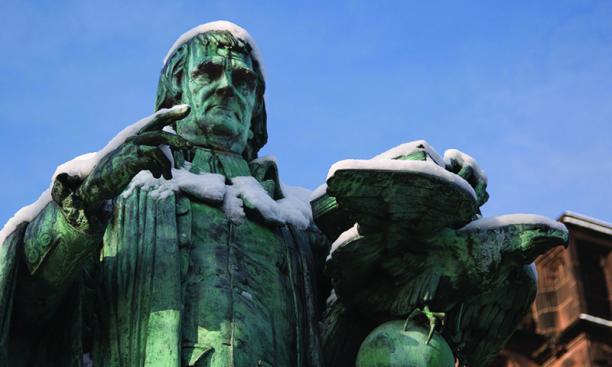
The University’s Committee on Naming is reviewing a proposal to remove or replace a campus statue of John Witherspoon, an influential figure in the American Revolution who owned slaves during his time as Princeton’s president.
Last May, five members of the philosophy department — graduate students Brendan Kolb, Kathryn Rech, Giulia Weissmann, and Waner Zhang, and Professor Boris Kment *06 — created a petition that said the statue, which has stood outside East Pyne Hall since 2001, “pays great honor … to someone who participated actively in the enslavement of human beings, and used his scholarly gifts to defend the practice.” The petition, signed by 285 members of the campus community, proposed replacing the statue with a plaque that “details both the positive and negative aspects of Witherspoon’s legacy.”
Witherspoon, who emigrated from Scotland to serve as the College of New Jersey’s sixth president, from 1768 to 1794, was the only clergyman and college president to sign the Declaration of Independence. The 10-foot bronze sculpture, created with an identical twin at the University of the West of Scotland, stands on a plinth with three tablets that explain his legacies as a patriot, president, and preacher.
But Witherspoon also had a “complex relationship to slavery,” according to Princeton & Slavery Project research by Lesa Redmond ’17, who wrote her senior thesis about the Witherspoon family’s ties to slavery in the United States. While Witherspoon tutored three free Black students during his time at Princeton, he also purchased two enslaved people to farm his country estate and voted against abolishing slavery in New Jersey.
The naming committee’s review “will be informed by rigorous research, scholarly expertise within and beyond the University community, and input from the broad University community,” according to a University release. The committee began holding listening sessions with alumni, faculty, staff, and students in late November and found “diversity of opinion about the statue among every constituency,” according to history professor Angela Creager, the committee’s interim chair.
Princeton’s Board of Trustees will have the ultimate say in any changes to the statue’s placement or presentation. In April 2021, the trustees adopted “Principles to Govern Renaming and Changes to Campus Iconography” (available online at bit.ly/re-naming), which established “criteria to help guide specific decisions about renaming and changing campus iconography.” Those criteria include determining whether the namesake was “significantly out of step with the standards” of the namesake’s time and if the space in question plays “a substantial role in forming community at the University.”
Kolb, Rech, and Zhang, who responded to questions from PAW by email, wrote that while Witherspoon, in his time, “didn’t stand out among people in power for a commitment to defending racist norms or power structures,” the towering statue and its high-traffic location unduly exalt his legacy.
“[O]ur argument has both aesthetic and moral dimensions,” they wrote, “based on the broad principle that depictions of a certain grandeur are inappropriate for certain spaces when the subject depicted was actively engaged in racialized slavery — a practice that separated out the humanity that Princeton aims to serve.”
